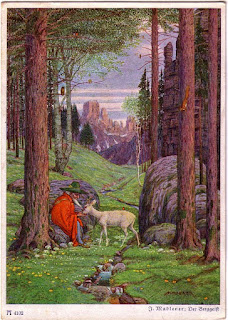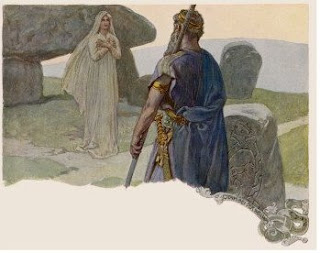Ordained at 26, he embarked on a series of voyages to found monasteries and monastic cells, traveling to the Aran Islands, Argyll, Wales, and Brittany. His most famous voyage is recorded in Navigatio Sancti Brendani Abbatis (Voyage of Saint Brendan the Abbot), written over 300 years after his death (in 577). In it, he heads into the Atlantic with several followers (numbers vary in different manuscripts).
The voyage takes seven years and visits many odd islands: the Isle of Birds, Isle of Sheep, the Island of Strong Men, an island with silent monks. The first island they come across is uninhabited, but one of his companions dies there (two others will die at different locations).
One interesting stop they make is on an island where everything seems calm and peaceful. When they light a fire, however, the island starts to move; they realize the "island" is actually the back of an enormous fish that has been floating on the surface of the ocean long enough for plants to grow on its back. The narrative calls this monster "Jasconius." It is a common legendary encounter in classical and medieval literature, but by a different name.
Was any of this narrative based on fact? Well, Brendan did voyage to islands to spread Christianity. The Navigatio says that Brendan finally reached the Promised Land for Saints before returning to Ireland. One of the places he found in 512 is referred to as St. Brendan's Isle: a land of thick vegetation where the sun never set, surrounded by a thick mist. He spent 15 days there. This island was put on future maps. The Portuguese prince known as Henry the Navigator (1394 - 1460) claims to have landed there, and later sailors reported seeing it.
A theory arose that St. Brendan's Isle where it was always day may have been Greenland, where the summer months see 24 hours of sunlight. There is a Saint Brendan Society that claims Brendan discovered North America, and at least one writer believes the details of the voyage prove that Brendan discovered Brazil! A man named Tim Severin proved that a boat like the one Brendan used could make the voyage from Ireland to Greenland.
Post-voyage, he continued to found monasteries, as well as a convent in Annaghdown for his sister, Briga. It was during a visit there to see his sister that he died. He was interred in Clonfert Cathedral. The Catholic Church recognizes his sainthood, and celebrates his feast day on 16 May. He is the patron saint of sailors and travelers.
Brendan is remarkable for the account of the legendary voyage ascribed to him many years later. A more remarkable figure in that time was Finnian of Clonard, about whom you'll learn more tomorrow. See you then.





























